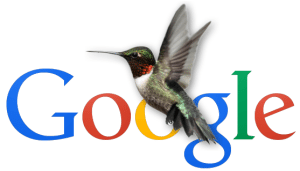 By now, you’ve probably heard about Google’s new Hummingbird algorithm. Phased in over a period of several weeks this summer, the update replaces a framework that had existed for at least a decade. Since it incorporated pieces of past algorithms, the Hummingbird switch didn’t totally upend Google’s results. Small business owners who were already producing relevant, useful content — we hope this means you — probably weren’t hurt by the change.
By now, you’ve probably heard about Google’s new Hummingbird algorithm. Phased in over a period of several weeks this summer, the update replaces a framework that had existed for at least a decade. Since it incorporated pieces of past algorithms, the Hummingbird switch didn’t totally upend Google’s results. Small business owners who were already producing relevant, useful content — we hope this means you — probably weren’t hurt by the change.
Keeping Things in Perspective
Before we get further into our discussion of Hummingbird, let’s address the elephant in the room: the ongoing, seemingly punitive nature of Google’s algorithm updates. Back when the Penguin and Panda updates – which aimed to improve the search rankings of sites with high-quality content and useful links — went live in 2011 and 2012, many business owners complained that Google was unfairly targeting their websites. In retrospect, those two algorithm updates were qualified successes: While they weren’t problem-free, they did lead to a reduction in black-hat marketing tactics and boosted the organic search visibility of relevant, engaging content. If you’re wondering why the Internet of late 2013 looks so different from the Internet of 2009, look to Penguin and Panda.
Here’s what we’re trying to say: Google makes a lot of questionable decisions, but complaining about them won’t get you very far. This is a huge, highly profitable business that’s simply trying to capture, organize and dispense the ever-growing volumes of information that pass over the Internet, and it’s bound to alienate some folks in the process. Rather than harp on the apparent drawbacks of Google’s new algorithm shifts, treat them as opportunities, not obstacles.
What’s Hummingbird’s Intent?
Well, Hummingbird’s intent is intent itself.
Allow us to explain. Search engines have long leveraged organic keywords to deliver search results. When the content marketing industry was very young, it was perfectly acceptable to use manipulative tactics like link spamming, meta tag stuffing, cloaking and more to boost pages’ keyword ranks. Ongoing algorithm improvements have more or less eradicated these problems and reduced ‘ reliance on organic keywords.
Like Google’s recent shift to fully encrypted search, Hummingbird represents another big step away from keyword-centric marketing and a step towards content-centric marketing. Indeed, the algorithm is the company’s first flirtation with “semantic search,” the natural-language, information-gathering techniques epitomized by Apple’s Siri tool. Using text inputs rather than audio data, Hummingbird aims to interpret the searcher’s intent — what he or she is trying to say, not how he or she is saying it — and return better results than a “dumb” keyword search.
How Does This Work?
Hummingbird “smartens up” search results by improving responses to long-tail queries, incorporating information from its growing Knowledge graph and paying careful attention to location data. In the past, a long-tail search like “Where can I find a good filet mignon?” might have returned corporate websites for direct-delivery companies like No Name Steaks, big-name grocery outlets like Costco and major steakhouse chains like Ruth’s Chris.
Post-Hummingbird, such a search returns far more relevant results: steakhouses near your current location — whether you’re lounging at home in Farmingdale or holed up in a hotel in Denver — as well as information about preparing and cooking filet mignon. You might still get ads for Morton’s Steakhouse or Omaha Steaks, but those won’t be the focus in your organic results. Overall, Hummingbird curates relevant, informative results that get to the heart of the matter, and future Google updates are sure to improve on its framework.
Making Hummingbird Work for You
There’s no longer any place for content marketing that doesn’t engage and inform its target audience. Hummingbird makes it even more important to understand your readers’ backgrounds, needs and motivations. Using information culled from previous leads and customers, create individual buyer personas and build “content silos” for each one. Use specific landing pages with rich, regularly updated multimedia content to capture inbound leads for each persona and carefully measure the relative performance of each. Now that Google’s semantic search feature aims to increase relevance by giving preference to local searches, mundane details like location are important as well.
Regardless of how you execute the nuts and bolts of your post-Hummingbird content marketing strategy, one thing is clear: It’s up to you to produce engaging, entertaining and informative content that speaks directly to your target audience(s). Don’t aim to close the sale on the first try. Instead, create content that positions your brand as an authority and lets leads know that you’ll be waiting when the time comes to buy. Remember, Hummingbird works for honest businesses like yours.
